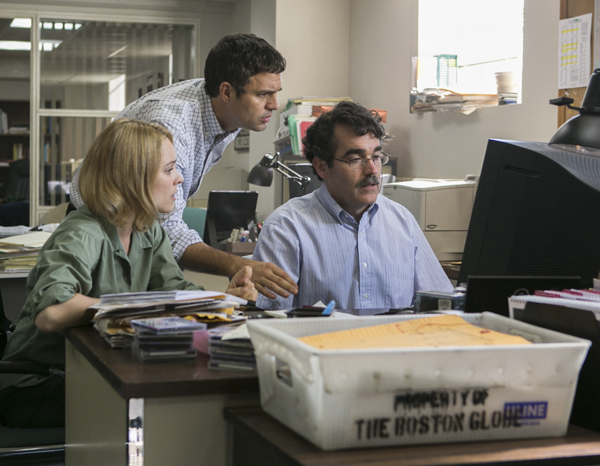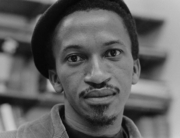
From Left, Rachel McAdams, Mark Ruffalo, and Brian d’Arcy James in Spotlight (Kerry Hayes/Open Road)
Just the facts, ma’am. That catchphrase from the old Dragnet TV series well describes director Tom McCarthy’s efficient, workmanlike approach to his beat-by-beat unmasking of a scandal. In 2002, the Boston Globe published an exhaustively researched exposé of how the city’s Roman Catholic diocese shielded hundreds of sexual abusers among its ranks for decades. This tribute to the fourth estate features a starry ensemble—Michael Keaton, Rachel McAdams, and Mark Ruffalo—and an extraordinary supporting cast, many of whom make an indelible on-screen impression. The re-creation of the local atmosphere adds credibility to the star power.
The script jumps straight to the point, getting down to business immediately; in other words, it doesn’t bury the lede. Martin Baron (Liev Schreiber), the Globe’s new editor-in-chief brought over from the Miami Herald, gathers his staff to ascertain what hot story they’re pursuing. A piece by staff writer Eileen McNamara (Maureen Keiller) has caught his eye: an editorial criticizing the impenetrably sealed settlement between the church and a sexual abuse claimant. Baron launches a lawsuit to unseal the legal document and gives the paper’s four-reporter investigative team of the “Spotlight” section room to explore a broader view of a possible pattern of behavior by the church hierarchy.
The earnest and clear-eyed film is perhaps more notable for what steps it doesn’t take. It avoids overexplanations and detailed backstories for the four reporters, who largely become the conduits for the audience into the evolving story. What viewers know about the reporters is strictly on a need-to-know basis. The most personal revelation centers on Walter “Robbie” Robertson (Keaton), who went to high school with a classmate whose name later appears on a list of victims.
The screenplay also refrains from zeroing in on one individual(s) as a stand-in for the church’s failings. The man held responsible for coordinating the private settlements, Cardinal Bernard Law, is portrayed more as a grandfather figure pressing the flesh with the city’s bigwig Catholic donors than as a conventional Machiavellian villain. Additionally, though the journalists are depicted as intrepid, they are far from infallible. The newspaper had pieces of the story all along; Robertson had written a story in 1997 that was buried in the Metro section, with no follow-up.
When the reporters track down a priest who had been relocated from one parish to another throughout his career, he appears as a soft-spoken, frail man in his seventies, as much to the bewilderment of the audience as to reporter Sacha Pfeiffer (McAdams). When she knocks on the front door of his plain, lower-middle-class home, he greets her and actually stays planted and answers her question with guileless honesty, offering his own legally unfounded definition of rape. After this and many other eyebrow-raising encounters, viewers will wonder, where did the casting directors find the supporting actors? Viewers are plunked right into South Boston. Unlike Ben Affleck’s The Town, in which, as Quentin Tarantino pointed out in New York Magazine, the cast playing down-and-out Southies were gorgeous, the actors of Spotlight look like they just walked off the street.
The film refrains from overt displays of emotion, and when it occurs, the tone abruptly changes from somber to melodramatic. In this case, the culprit is out in the open: Mark Ruffalo, who, with this role as reporter Mike Rezendes and his addled but lovable lug in the recent Infinite Polar Bear, wears his emotions on his sleeve and all over. He delivers the indignant Big Speech, the equivalent of the 11 o’clock Broadway number, in which he spews his anger, accompanied by a score that offers an unneeded benediction. This heavy-handed editorializing reiterates what many in the audience has been thinking. We’re with you already, buddy.
Though it’s set in 2001–02, the film is already a period piece, when the Sunday edition of the local paper was so heavy it could be a weapon and when deadlines were somewhat more flexible. The newspaper ran the story (eight months in the making) only when everything was double-checked and then some, at the risk of being scooped by another paper. Reference librarians will rejoice: not every research material had yet been digitized, and the reporting team had to rely on the dusty diocese directories to track the whereabouts of priests who were placed on sabbatical or sick leave or had been assigned to a church-run treatment center. The painstaking research for this part of the fact-finding mission is glossed over, but then again, thanks to the movie’s overall methodical pace, the viewers’ eyes never glaze over, either.
McCarthy’s practical directorial choices carry over to the set design, which replicates Spotlight’s utilitarian basement offices, downscaling from the likes of other newsroom-set films, such as All the President’s Men, with its endless row of desk and hyperactivity. At its most stripped down and plainspoken, Spotlight allows the record to speak for itself.






Leave A Comment